 The whole world sings with her—except Bogart. 
The first time we saw Lizabeth Scott sing was in the film noir Dead Reckoning, in which she starred with Humphrey Bogart. Scott breaks into a little torch number while they're at dinner. Old fims, including old noirs, often required female leads to sing, but having Scott sing at the table was a twist. Unlike the normal set-up in which the actress sings onstage sa a performer in a nightclub or casino, it was closer to the technique that would become standard in musicals, with the song flowing directly from the dialogue. Bogart mostly seemed baffled, possibly even spooked. You can see what we mean here.
We realized only recently that Scott, backed by Henri René and His Orchestra, released this 1958 album on RCA. She has a somewhat smoky speaking voice, so we were intrigued by the possibilities of an album. She performs such classics as “I'm in Love Again,” and “When a Woman Loves a Man,” and her vocal instrument is really nice, residing in the deep and mellow mode. If you like orchestral pop music you'll probably like the record. Give her a listen here and here, while the links last.
 They're going to salvage a lost cargo come hell or Haie water. 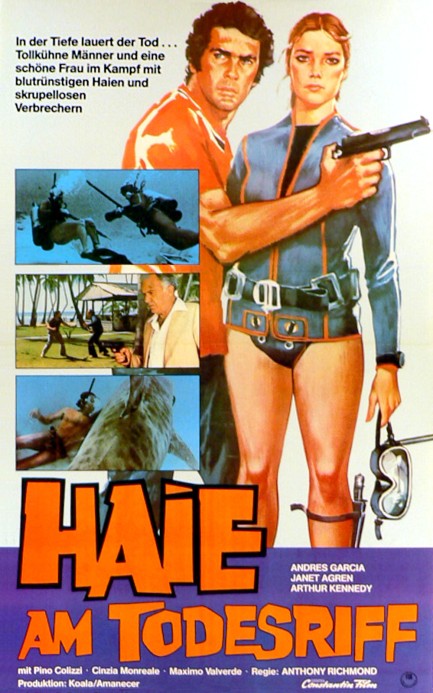
We had a foreign double feature last night, following up La tentación desnuda with Haie am Todesriff, which was originally Italian made as Bermude: la fossa maledetta. Known in English as Cave of Sharks, it premiered in Italy in June 1978 and opened in West Germany today the same year. It is, to be succinct, a Jaws knock-off made with less imagination and less budget. Set on and around the fictive island of San Domingo, which is somewhere near Bermuda, the movie stars Andrés Garcia as a member of an oceanographic expedition who turns up with amnesia six months after his boat goes missing and his colleagues are lost. During those six months that Garcia was presumed dead, his brother tried to move in on his girl Janet Agren—for which he cannot in any be blamed—but with his bro's reappearance there's now a budding love triangle.
Later a plane crashes near San Domingo under strange circumstances with an illegal cargo, sending organized crime figures into to action to recover their loot. Under false pretenses, they hire Garcia, sending him right back into the dread sector of ocean from he'd been fished. He discovers strange, mystical sharks, and thinks they might be the key to getting his memory back. He loses all interest in the crooks' treasure, but they think he's found it and is withholding it. Trouble looms. Does all this sound dumb? You aren't wrong. And the bad plot isn't helped by bad acting, bad action, and incredibly bad miniature work. This one isn't worth your time, even with Janet Agren in the co-starring role. But to make reading this worthwhile, we've added a nice Agren shot to the promos below.
 Looking pretty sharp, Gayle. 
Have you ever seen a profile like this? It belongs to Texas born actress Gayle Hunnicutt, who we last saw in 1969's Marlowe with James Garner. She also appeared in The Wild Angels, The Spiral Staircase, The Legend of Hell House, and several other pulp-pertinent flicks before migrating over to television. She retired from acting in 1999, but her sharp profile will always be remembered.
 Not only was she explosively sexy, but her voice could blow you away. 
We love this nuclear themed 45 sleeve for an Abbe Lane four song disc, which we guess is titled simply Abbe Lane. It came from RCA Española and was released in Spain in 1958 with the offerings: “Que será será,” “¡Ay! Que Me Vuelvo Loca,” “Banana Boat (Day-O),” and “Very Satisfied.” All four songs are easy to sample online, so give them a whirl if you wish.
The rear sleeve text is fun. It says: Abbe Lane is without a doubt one of the most popular and applauded voices of the current musical moment. All her performances are hits and the songs she sings come to us covered in a rhythm and color that make them even more seductive.
Without a doubt, the secret of her success lies in herself, in her warm voice, in her exquisite way of conveying the message of her music to the listener, in her magnetic figure and great physical attractiveness.
In this recording, Abbe Lane sings in English and Spanish, interprets two calypsos, a fashionable rhythm that has come to dispute the primacy enjoyed by the much-discussed “rock and roll,” and two melodies that will be popular through the warm voice of the artist pampered by the public and critics worldwide: Abbe Lane.
The promotional staff at RCA Española might have loved Lane, but they couldn't spell. They open the third paragraph by calling her “Abre,” instead of Abbe. That amused us. We also like how, according to the front office brains, calypso was supplanting rock and roll. Really? Well, it turned out to be a marathon, not a sprint. We have a bonus shot of Lane below, for your viewing pleasure.
 Don't hate the Playa, hate the games. 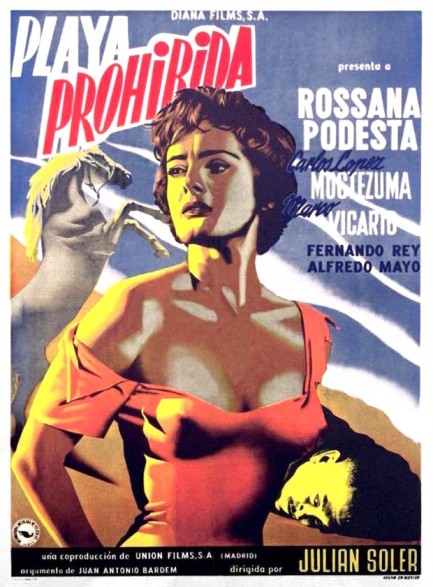 
Playa prohibida was a Mexican-Spanish co-production filmed on Mallorca, starring Rossana Podesta, that premiered in Mexico today in 1956 and reached Spain the next year, in March 1957. Above are the Mexican and Spanish posters, both quite nice we think. They're differentiated by the fact that one gives second billing to Carlos López Moctezuma, who was Mexican, while the other gives second and third billing to Spanish actors Fernando Rey and Alfredo Mayo. Podesta plays a woman living in a beach town, and everyone thinks she's daft. When she's found on the beach standing over a corpse and looking guilty, the cops want to pin the crime on her, but a screenwriter passing through takes up the mystery and—with the help of his story construction skills—tries to figure out what happened. He narrates a significant part of the film, but other characters apply voiceover too, including the allegedly mad Podesta. The puzzle is eventually solved, and as you'd expect it's layered with jealousy, greed, betrayal, and all the usual games. If you're thinking this sounds a bit familiar, that may because the setting bears some resemblance to Podesta's 1953 Mexican made thiller La red, in which she was also a somewhat enigmatic woman living in a small seaside community. We suppose when Mexican filmmakers thought "exotic beach beauty" Podesta came to mind, and why not? Just look at her. Her presence alone makes Playa prohibida worth a viewing, at least for us. And possibly for you too. For the moment—i.e. while the link lasts—you can watch it on YouTube and decide for yourself. Spanish required. 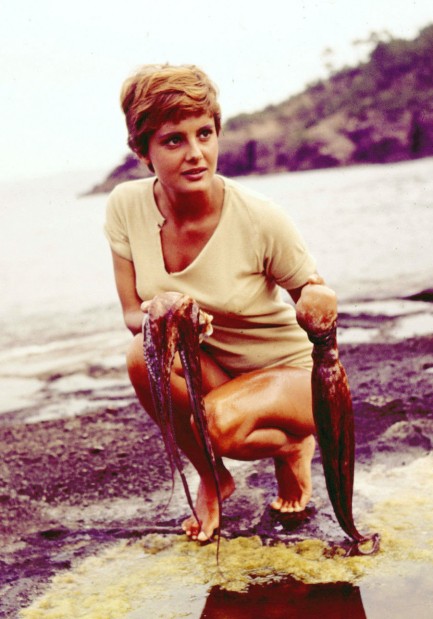
 Should she stay or go? The chair may be the factor that tips her one way or the other.  
This rare poster of U.S. actress Candice Bergen was printed and distributed in 1972 by a company called Nats Co-operated Reproduction. The shot was made in 1968 by famed photographer Terry O'Neill. There are other photos from the session. A couple even feature the same weathered beach chair that looks set to snap at any moment like something made from chopsticks, but as far as we know only Nats Co-operated used a color shot of Bergen in this particular pose. We've seen a black and white on Getty Images, but never one in color until this treasure. The beach, incidentally, immediately looked to us like our occasional stomping grounds the Balearic Islands, and sure enough, when we checked it turned out Bergen sat for this when she was filming The Magus in Mallorca. Another shot from the session appears below.
 Another valuable Spanish painting is ruined by someone who's all thumbs and no skills. 
Spanish art restorers are in the news for the wrong reasons again. You may remember the infamous Ecce Homo disfigurement—the early 20th century fresco by Elías García Martínez that was ruined by amateur restorer Cecilia Giménez. The restoration, which took place in the town of Borja, was so botched that many Spaniards stopped referring to the painting as Ecce Homo—“Behold Man”—in favor of Ecce Mono—“Behold Monkey.” We've posted its Christ figure, angelic before, and afflicted after, below. We think the name change fits, though we think the after Christ also looks a bit like Leatherface.
The Ecce Homo fiasco soon grew to exemplify the divergent incentives of the modern world. The painting was destroyed. Its destruction turned the painting and the town of Borja into a tourist attraction. The restorer now claims she's proud of her work because of the money that tourists   bring which can be used for good causes. The fact that these calamity tourists are posing with the painting only because it looks like Giménez restored it using a brush held between her ass cheeks is now immaterial. Only money matters. The money made has absolved her of responsibility for ruining the art. bring which can be used for good causes. The fact that these calamity tourists are posing with the painting only because it looks like Giménez restored it using a brush held between her ass cheeks is now immaterial. Only money matters. The money made has absolved her of responsibility for ruining the art.
The latest incident involves a more-than-century-old copy of Bartolomé Esteban Murillo's baroque painting La Inmaculada del Escorial, which you see at top. An art collector in Valencia hired a furniture restorer to clean the painting, but the face of the Virgin Mary was damaged. The collector then hired an art restorer to repair the damage, was forced to hire a second to fix the damage done by the first, and, well, see below. Now look up top again. Now look below. Yeah, that actually happened. We can't figure out how the second restorer made the painting look even less like the original than the first restorer. Did they not understand why they had been hired? These paintings aren't pulp art, but their destruction is like something from a comical crime novel. Not surprisingly, some Spaniards also consider these blunders criminal, and are now calling for regulation of the art restoration sector, and who can blame them?
Spanish art experts say botched restorations are more common than people know. We searched around and found a couple more, also hilariously awful (see the sculpture of St. George from the town of Estella, below). Generally, these incidents only become public when they're reported to the press or on social media, which isn't the norm, considering the embarrassment involved. But we can't help wondering if, going forward, ancient artworks will be deliberately ruined as a ploy to generate calamity tourism. We wouldn't put it past people. Maybe Behold Monkey should be renamed again, to Behold Money. Maybe Jesus has shown the way—to financial salvation. 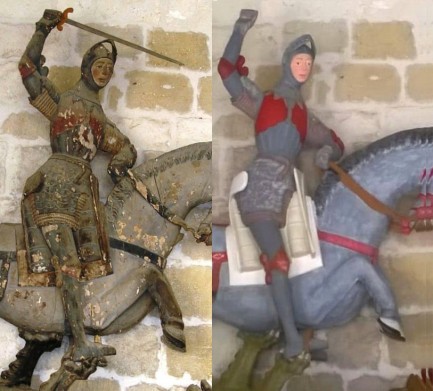 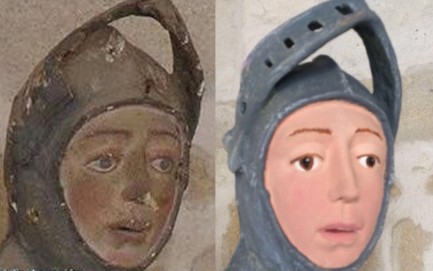
 Sun, sand, and an unusually high homicide rate.  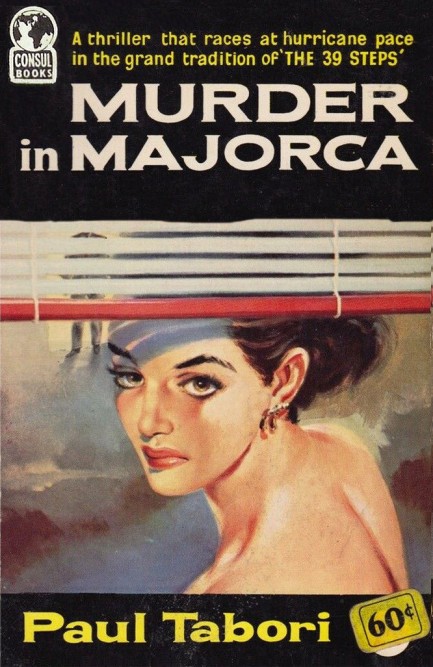
Of all the covers we've posted on Pulp Intl., these two—the first from U.S. publisher Dell, and the second from British publisher Consul—are among the most interesting. Both illustrate books called Murder in Majorca, both feature a female figure partly obscured by foreground blinds, and both have in the background the lower legs of a man walking into the room. But Michael Bryan and Paul Tabori are different authors, and these are different tales. Is that not weird as hell? We've always wanted to read these books because Majorca, aka Mallorca, is one of the great garden spots on Earth. We've been several times and it always recalibrates us perfectly. Also, there isn't much murder there, despite the titles of these books, which is a nice add-on to the sun, sand, food, bars, architecture and beautiful people.
Michael Bryan was in reality Brian Moore, and also wrote as Bernard Mara. His Murder in Majorca appeared in 1957. Paul Tabori was in reality Hungarian author Pál Tábori, and his Murder in Majorca came in 1961. How did these two uncredited covers get to be virtually identical? No idea. Sometimes when a book was reprinted overseas a second artist was commissioned to do a riff on the original cover, such as here. So maybe the second piece was for a re-issue, but it fell through, and the art was lying around when Tabori wrote his book. That's a wild-ass guess that has very little chance of being correct, but we just know these two fronts can't be similar by coincidence, so that's all we've got by way of explanation. Maybe you have a better deduction, or even the facts. If so, we'd love to know.
 Monroe goes for a spin in Italy. 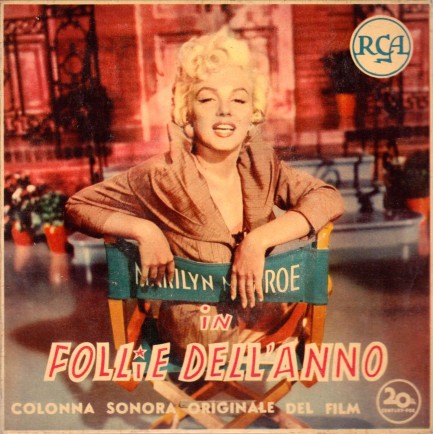
Marilyn Monroe fronts this RCA soundtrack album sold in Italy featuring songs from the film Follie dell'anno, which originally appeared in the U.S. as There's No Business Like Show Business. There are four numbers written by Irving Berlin here and Monroe handles the vocals. If you want this platter it'll cost you probably a hundred dollars or more, so good luck with that. We're content to enjoy the sleeve. The shot of Monroe turned backward in her director's chair is one we've never seen before. 
 Elizabeth Taylor has a stroll under the Spanish sun. 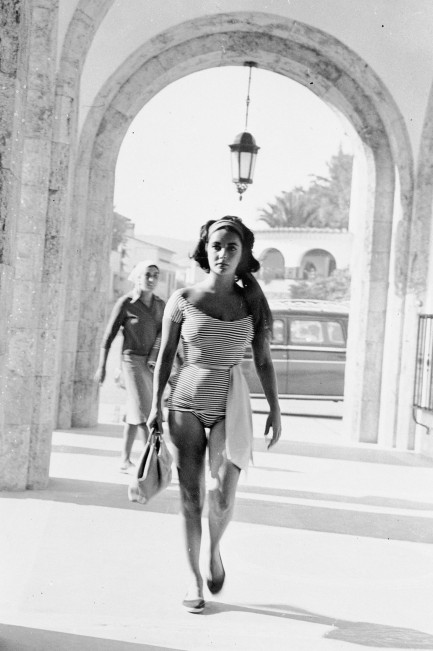
We just saw Liz Taylor a couple of weeks ago, but we're bringing her back because we liked this shot of her heading for the beach somewhere on the Costa Brava, Spain, during the production of her drama Suddenly Last Summer. We know Spain quite well, so we challenged ourselves to identify this exact location. Many sites say the photo was shot in S'Agaro, but we don't think so. There are no arches quite like this in that town, not even along the Cami de Ronda that runs along the coast. Part of the movie was also filmed in Mallorca, but we definitely can't think of anyplace on Mallorca that has old architecture of this size near a beach, so call us stumped for now. The shot was made today in 1959.

|
 |

The headlines that mattered yesteryear.
2003—Hope Dies
Film legend Bob Hope dies of pneumonia two months after celebrating his 100th birthday. 1945—Churchill Given the Sack
In spite of admiring Winston Churchill as a great wartime leader, Britons elect
Clement Attlee the nation's new prime minister in a sweeping victory for the Labour Party over the Conservatives. 1952—Evita Peron Dies
Eva Duarte de Peron, aka Evita, wife of the president of the Argentine Republic, dies from cancer at age 33. Evita had brought the working classes into a position of political power never witnessed before, but was hated by the nation's powerful military class. She is lain to rest in Milan, Italy in a secret grave under a nun's name, but is eventually returned to Argentina for reburial beside her husband in 1974. 1943—Mussolini Calls It Quits
Italian dictator Benito Mussolini steps down as head of the armed forces and the government. It soon becomes clear that Il Duce did not relinquish power voluntarily, but was forced to resign after former Fascist colleagues turned against him. He is later installed by Germany as leader of the Italian Social Republic in the north of the country, but is killed by partisans in 1945.
|

|
|

It's easy. We have an uploader that makes it a snap. Use it to submit your art, text, header, and subhead. Your post can be funny, serious, or anything in between, as long as it's vintage pulp. You'll get a byline and experience the fleeting pride of free authorship. We'll edit your post for typos, but the rest is up to you. Click here to give us your best shot.

|
|





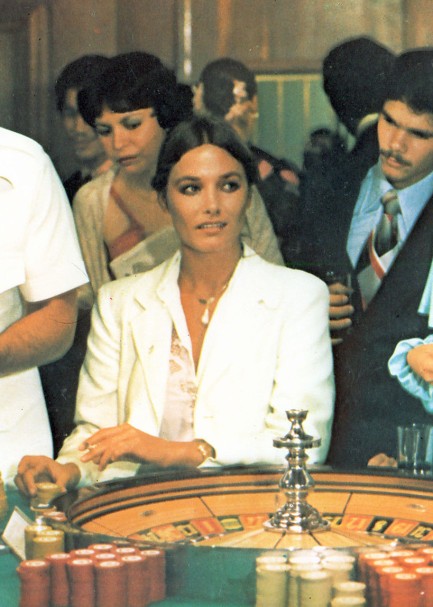
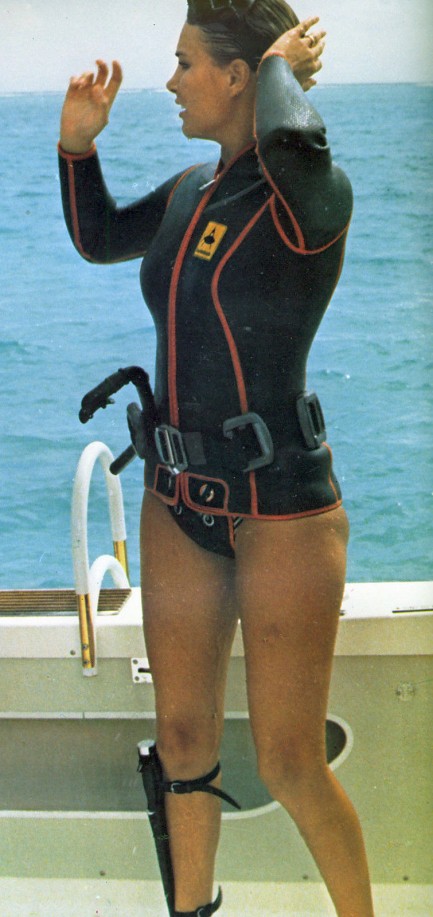
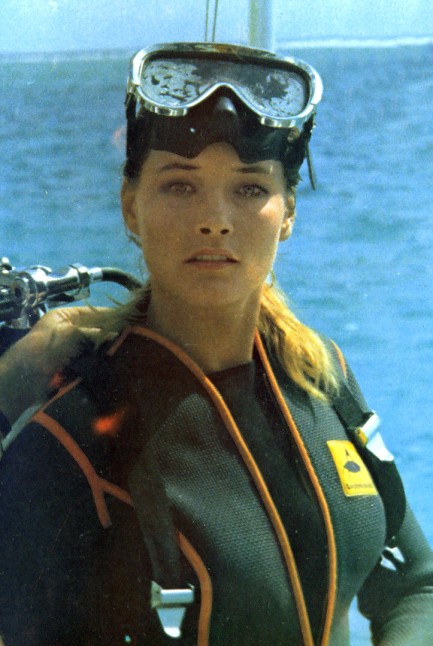
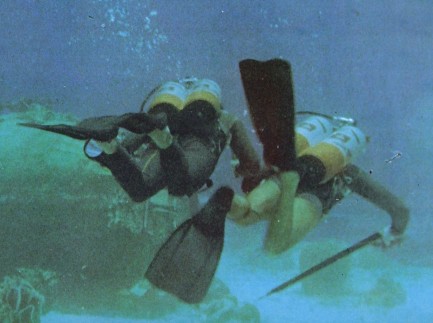
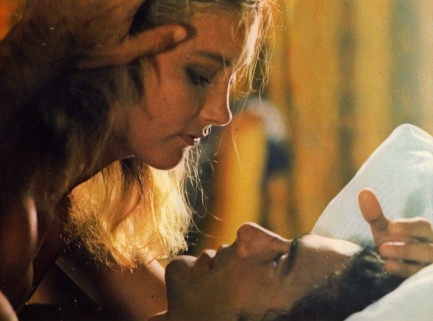





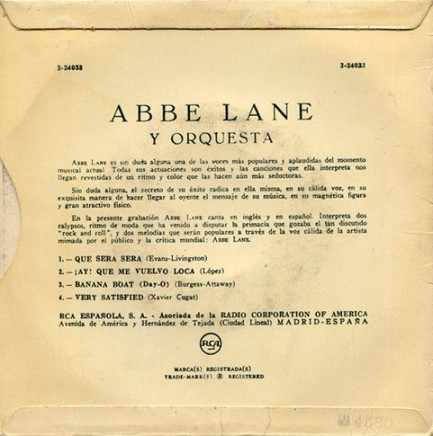







![]()
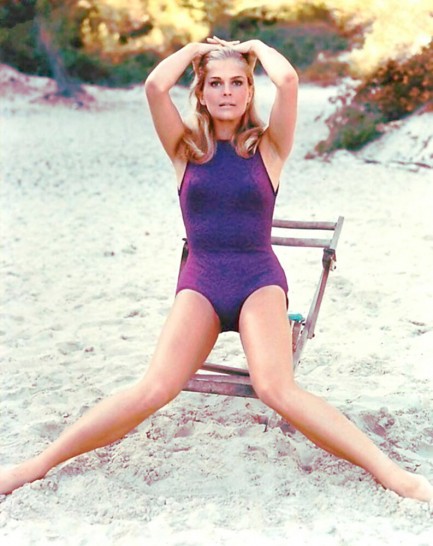



 bring which can be used for good causes. The fact that these calamity tourists are posing with the painting only because it looks like Giménez restored it using a brush held between her ass cheeks is now immaterial. Only money matters. The money made has absolved her of responsibility for ruining the art.
bring which can be used for good causes. The fact that these calamity tourists are posing with the painting only because it looks like Giménez restored it using a brush held between her ass cheeks is now immaterial. Only money matters. The money made has absolved her of responsibility for ruining the art.
















































































